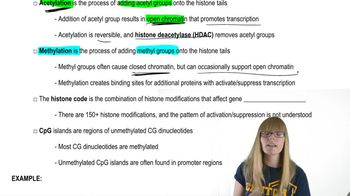Here are the essential concepts you must grasp in order to answer the question correctly.
Amino Acid Classification
Amino acids are organic compounds that serve as the building blocks of proteins. They can be classified based on their side chains into three categories: positively charged (basic), negatively charged (acidic), and electrically neutral (polar or nonpolar). This classification is crucial for understanding how amino acids interact with other molecules, including DNA.
Recommended video:
Acetylation
Acetylation is a post-translational modification where an acetyl group is added to a molecule, often a lysine residue in proteins. This modification can neutralize the positive charge of lysine, reducing its affinity for negatively charged DNA. Consequently, acetylation can influence the accessibility of DNA for transcription factors, thereby playing a significant role in gene expression regulation.
Recommended video:
Histone Protein Modifications
Gene Expression Regulation
Gene expression regulation refers to the processes that control the timing and amount of gene product (RNA or protein) produced in a cell. Modifications like acetylation can alter chromatin structure, making DNA more or less accessible for transcription. This dynamic regulation is essential for cellular responses to environmental signals and developmental cues.
Recommended video:
Penetrance and Expressivity
 Verified step by step guidance
Verified step by step guidance Verified video answer for a similar problem:
Verified video answer for a similar problem:
